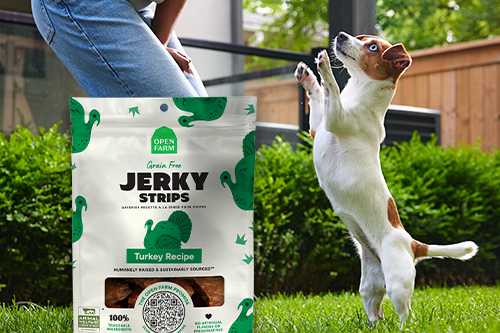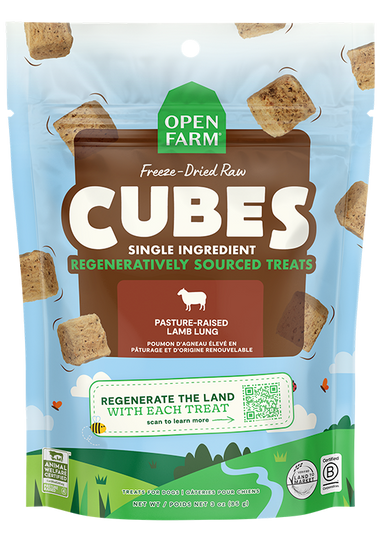In September 2023, we announced our commitment to support the transition of 1 million acres of farmland to regenerative management. While we set this commitment less than a year ago, our purpose to Do Some Good for Animals and the Planet has been a consistent part of our DNA since we were founded in 2014. Our dedication to growing ingredients in a humane and sustainable way serves as a critical foundation to drive this regenerative transition. For us, regenerative agriculture is a holistic approach to managing land that seeks to drive positive outcomes for the land, farmers, animals, and of course our pets. Regenerative agriculture is not a new idea – rather, it is a return to managing the land in a way that honors nature.
Why Regenerative Agriculture
The outcomes of a regenerative approach start with a foundation in healthy soils. While it may not be obvious, soil is a living microbiome that serves as the starting point for food for us and our pets. In fact, 95% of the food that we eat is produced in or on soil1. While the research is still emerging, studies have already shown a positive link between regenerative management and the quality and nutrient density of the foods grown, including higher rates of key vitamins in crops2, such as magnesium, calcium, iron, and zinc and more nutritious fatty acid profile in meats3. The nutrition that our pets need to thrive starts in the soil.
There is a virtuous cycle between the ways in which we can improve soil health and the key benefits we see. For example, when a rancher rotationally grazes her cattle, the grasses can grow deeper roots during rest periods, which are able to hold more water and more carbon. This means the land is more resilient to natural disasters, there is better food available for her cattle, and she doesn’t need to supplement their diets as much. A win for the land, rancher, the cattle, and your pet.
The specific practices that farms can implement vary significantly because every farm is different -- their geography, the crops, or animals they’re raising, the topography of the land, weather patterns, rainfall, etc. all impact farming methods. However, we know that there are a few tried and true principles that help land, crops, and animals thrive no matter where farmers are in the world or what they’re raising- focusing on minimal disturbance of the soil, keeping living roots in the ground, integrating animals, protecting and supporting biodiversity, minimizing the introduction of fertilizers and pesticides, and being good stewards of water. We’ve seen our growers implement these practices to great success, and we’re on a mission to help more growers convert to a regenerative way of farming and ranching. Regeneratively managed farms and ranches leads to increased nutrient density which is the catalyst for the virtuous cycle and positive outcomes for all involved.
At Open Farm, we know that 99% of the products we sell have at least one ingredient that is reliant on soil. For each of these ingredients, (and our seafood ingredients too!) we are obsessed with giving pets the best quality ingredients and highest nutrition possible, all while sourcing sustainably and ethically. By investing in soil health, we can drive positive outcomes, including carbon reductions and sequestration, improved nutrient density of our foods, improved resiliency in the face of things like droughts, and higher welfare outcomes for farm animals.
What We're Doing During This Earth Day
While it feels like we celebrate Earth Day everyday here at Open Farm, we love any opportunity to support positive outcomes for the planet and raise awareness of the importance of how we grow our food.
We work directly with our growers to implement practices on their land to increase regeneration. This has a direct positive impact for the acres in our value chain, but we know that the issues are bigger than just us. That is why we want to help change the larger agricultural system.
This Earth Day, in addition to working within our own supply chain, we’re supporting an organization that has been a critical driver of the transition to regenerative agriculture for the world’s grasslands – The Savory Institute. The Savory Institute is a non-profit based in Boulder, Colorado with 50+ regional learning Hubs around the globe with an audacious goal of influencing management on 1 billion hectares of land —that’s nearly half the size of the entire United States!4. Since their founding in 2009, the Savory Institute has trained over 28,000 farmers, ranchers, and pastoralists and influenced management of nearly 37 million hectares of grasslands through a process that mimics ancestral grazing patterns of wild herbivores that co-evolved with healthy grassland ecosystems.
How You Can Get Involved
For every order placed during Earth Week, we’re supporting the transition of 10 acres to regenerative land management through our partners at the Savory Institute. That’s more than 7 football fields! When we’re facing huge issues like natural disasters, carbon emissions, and climate change, no action is too small, and we’ll need to work together to transform the system and create the future we want.
For those looking to go the extra mile to support regenerative agriculture, you can consider becoming a Regenerating Member of the Savory Institute. You’ll be helping to bring training and support to more farmers and ranchers around the globe. Learn more at https://savory.global/member.
We’re proud to partner with growers in our supply chain, The Savory Institute, and pet parents—each of whom values Doing Some Good for animals and the planet – on this critical transition. We’re excited to continue this regenerative journey this Earth Day and beyond.








































 Sign In
Sign In
 Create Account
Create Account





